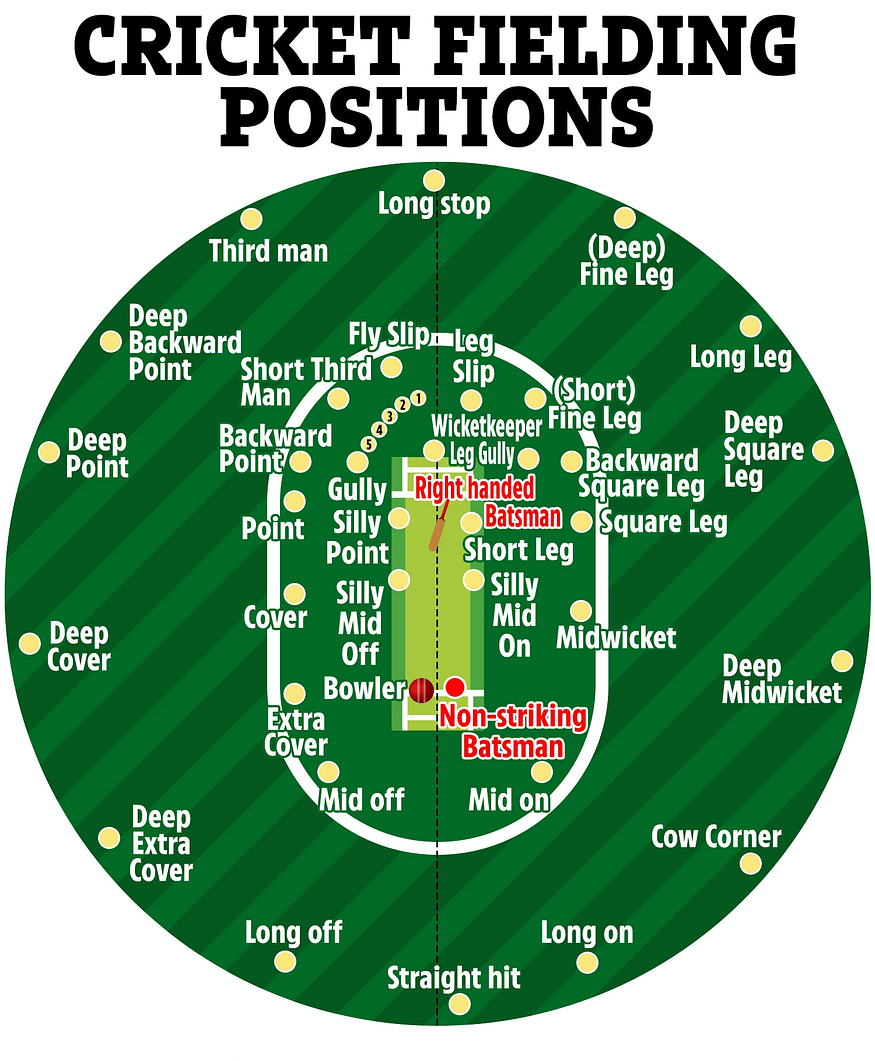
Cricket positions, often referred to as the gentleman’s game, is a sport known for its rich history, complex rules, and diverse strategies. While batting and bowling receive much of the spotlight, fielding positions in cricket play an equally crucial role in determining the outcome of a match. In this article, we will explore the various cricket fielding positions and their significance in the game.

Understanding Cricket Fielding Positions
In cricket, there are several fielding positions that players strategically occupy on the field to assist the bowler in dismissing the batsmen and preventing runs. These positions can be broadly categorized into three groups: close-in fielders, boundary riders, and the wicketkeeper.
1. Close-In Fielders:
a. Slip Fielders: Positioned close to the wicketkeeper, slip fielders are crucial for catching edges from the batsman’s bat. They are typically placed in the slip cordon, which includes first slip, second slip, and so on.
b. Gully: The gully is located adjacent to the slip fielders and is responsible for catching balls that might fly off the edge but not directly behind the wicket.
c. Silly Point: This position is right in front of the batsman and is used to catch shots that pop up off the bat or pad.
d. Short Leg: Short leg stands close to the batsman on the leg side, attempting to catch balls that may touch the batsman’s body or gear.
2. Boundary Riders:
a. Long-On: Positioned on the leg side boundary, long-on prevents the ball from reaching the boundary when batsmen play lofted shots in that direction.
b. Long-Off: Similar to long-on, long-off is stationed on the off side boundary to field lofted shots in that direction.
c. Deep Mid-Wicket: This fielder guards the boundary on the leg side and is essential when batsmen attempt powerful pulls or hooks.
d. Deep Fine Leg: Located on the leg side boundary behind the wicket, this fielder prevents balls from reaching the boundary when batsmen glance or sweep.
3. The Wicketkeeper:
a. Wicketkeeper: The wicketkeeper is arguably the most critical fielding position in cricket. Positioned behind the stumps, they are responsible for catching deliveries, stumping the batsman, and effecting run-outs.
Strategic Significance of Fielding Positions
Fielding positions in cricket are not randomly chosen; they are meticulously planned based on various factors such as the batsman’s strengths and weaknesses, the bowler’s line and length, pitch conditions, and the stage of the game. Here’s why they matter:
1. Taking Wickets: Close-in fielders are instrumental in taking catches off the bat’s edge or body, while boundary riders aim to restrict boundaries and catch lofted shots.
2. Building Pressure: Strategic placement of fielders can build pressure on the batsmen, forcing them to make mistakes and play rash shots.
3. Saving Runs: Boundary riders prevent the ball from crossing the boundary, saving crucial runs for their team.
4. Assisting the Bowler: Fielders can signal the bowler by their positioning, helping them adjust their line and length accordingly.
5. Wicketkeeping Brilliance: A skilled wicketkeeper can make the difference with their ability to take catches, effect stumpings, and execute quick run-outs.
Conclusion
In cricket, the battle between bat and ball is not complete without the active involvement of fielding positions. Each fielding position has its unique role and significance in influencing the game’s outcome. Whether it’s a brilliant catch in the slip cordon, a diving stop at the boundary, or a swift stumping behind the stumps, cricket field positions are an integral part of this elegant sport, adding layers of strategy and excitement to every match. So, the next time you watch a cricket match, pay attention to the intricate dance of fielders and appreciate the chess-like strategy behind their placements on the field.























